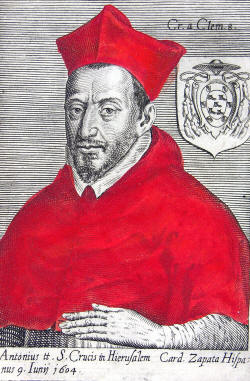Antonio Zapata y Cisneros facts for kids
Quick facts for kids Antonio Zapata y Cisneros |
|
|---|---|
 |
|
| Orders | |
| Consecration | 1587 |
| Created Cardinal | 6 June 1604 by Clement VIII |
| Personal details | |
| Born | 8 October 1550 Madrid |
| Died | 27 April 1635 (aged 84) Madrid |
Antonio Zapata y Cisneros was an important Spanish leader. He was born in Madrid on October 8, 1550, and passed away there around April 27, 1635. He held many powerful positions during his life.
Antonio Zapata served as a bishop in Cádiz and Pamplona. He also became an archbishop in Burgos. Later, he was made a cardinal, which is a very high rank in the Catholic Church.
Beyond his church roles, he was a councillor of state for King Philip III. He also served as the Viceroy of Naples, governing that region for the king. Finally, he became the Inquisitor General for all of Spain.
Contents
Antonio Zapata's Early Life and Career
Antonio Zapata y Cisneros was the first child of Francisco Zapata de Cisneros, who was the 1st Count of Barajas. His mother was María Clara de Mendoza. He was also a grand-nephew of the famous Cardinal Cisneros.
Studying and Becoming a Bishop
Antonio studied at the University of Salamanca. He earned a degree in Canon Law, which is the law of the Catholic Church. After his studies, he became a canon and an inquisitor in Toledo. Later, he moved to Cuenca, where his uncle, Gómez Zapata, was the bishop.
In July 1587, Antonio gave up his noble title. He passed it to his brother, Diego. In November of that same year, King Philip II helped him become the bishop of Cádiz. Cardinal Gaspar de Quiroga officially made him a bishop. While he was bishop, he paid to build part of the city walls in Cádiz.
Moving to Pamplona and Burgos
In May 1596, Antonio was sent to lead the diocese of Pamplona. A few years later, in 1599, he became a councillor of state. This meant he advised the king on important matters.
In September 1600, King Philip III made him the archbishop of Burgos. In this role, he helped make the city's cathedral even more beautiful.
Becoming a Cardinal and Moving to Rome
In June 1604, Pope Clement VIII named Antonio a cardinal. This was a very important honor. After this, he left his job as archbishop and moved to Rome. He lived there for several years.
He took part in a special meeting called a conclave in 1605. In this meeting, Pope Paul V was chosen. Antonio also served as the inquisitor for the city of Rome.
In 1617, he returned to Spain. He brought with him the remains of Saint Francis Borgia. Two years later, he gave the cardinal's hat, called a galero, to Prince Ferdinand of Austria.
Serving as Viceroy of Naples
In September 1620, King Philip III gave Antonio the job of Viceroy of Naples. He arrived in Naples at the end of that year.
Challenges in Naples
Soon after, Pope Paul V passed away. Antonio traveled back to Rome to join the conclave. There, a new pope, Gregory XV, was elected. While Antonio was away for less than a month, Naples was managed by Pedro de Toledo.
During Antonio's time as viceroy, Naples faced big problems. The country had serious inflation because money was being illegally copied. Bad weather also made things worse. It kept the kingdom isolated for months, making trade difficult. People in Naples were very unhappy with his leadership. They protested strongly, and sometimes even physically attacked the viceroy. In December 1622, Antonio was replaced by Antonio Álvarez de Toledo y Beaumont.
Return to Spain and Later Life
After his time in Naples, Antonio returned to Spain. In 1625, he was put in charge of the Archdiocese of Toledo. He managed it while the main archbishop, Cardinal-Prince Ferdinand of Austria, was still young.
In January 1627, Pope Urban VIII gave him the important job of inquisitor general for Spain. Five years later, when he was in his eighties, he decided to retire from all his roles. He moved to Barajas.
Antonio became ill and had trouble speaking. He was taken to Madrid, where he passed away in April 1635. His body was buried in the Discalced Carmelite monastery. This monastery was founded by his father in Barajas.
Antonio Zapata also wrote a book. It was called Discourse on the prelate's obligation of conscience and justice in the provision of ecclesiastical offices and benefits. He dedicated this book to the Cardinal-Prince. It was published in Madrid in 1629.
See also
 In Spanish: Antonio Zapata y Cisneros para niños
In Spanish: Antonio Zapata y Cisneros para niños

